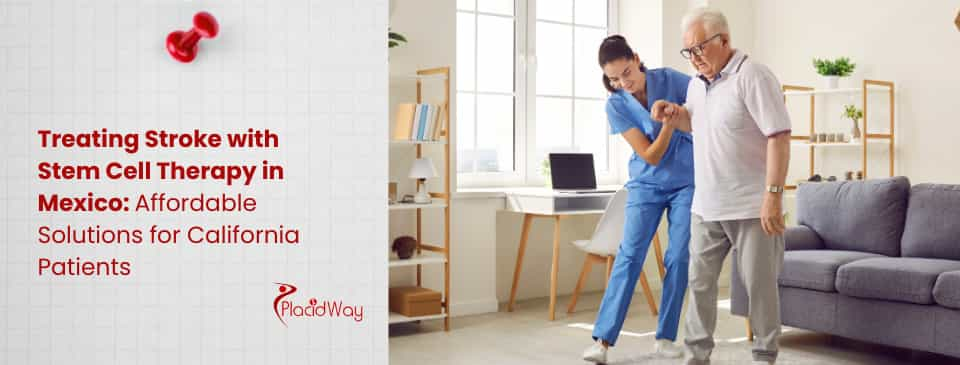For California patients seeking advanced stroke recovery options, stem cell therapy in Mexico offers a promising and affordable alternative. By harnessing the body’s natural healing mechanisms, this cutting-edge treatment aims to repair brain tissue damaged by a stroke, potentially improving motor function, speech, and overall quality of life at a fraction of the cost in the United States.
Key Takeaways
- Significant Savings: California patients can save 60-80% on stroke treatment by choosing stem cell therapy in Mexico compared to costs in the U.S.
- Advanced Protocols: Mexican clinics often use mesenchymal stem cells (MSCs), which are known for their potent anti-inflammatory and regenerative properties, to aid in neurological recovery.
- Proximity and Accessibility: For those in California, top-tier clinics in cities like Tijuana are just a short drive away, making travel for treatment convenient and minimizing downtime.
- Comprehensive Care Packages: Many packages include not just the treatment but also consultations, accommodation, ground transportation, and translation services.
| Country | Average Cost of Stem Cell Therapy for Stroke |
| Mexico | $8,000 – $25,000 |
| United States | $40,000 – $100,000+ |
| South Korea | $20,000 – $45,000 |
| Germany | $25,000 – $50,000 |
🧬 What is Stem Cell Therapy for Stroke?
Stem cell therapy for stroke is an innovative regenerative treatment that uses stem cells to repair and replace brain cells damaged by a lack of oxygen during an ischemic or hemorrhagic stroke. The goal is to restore neurological function and improve long-term recovery outcomes.
When a stroke occurs, the blood supply to a part of the brain is cut off, causing brain cells (neurons) to die. This damage leads to the physical and cognitive impairments associated with strokes, such as paralysis, speech difficulties, and memory loss. Traditional rehabilitation helps patients regain some function, but it cannot repair the underlying brain damage.
Stem cell therapy introduces a new approach. The therapy typically involves administering mesenchymal stem cells (MSCs), which are multipotent cells capable of differentiating into various cell types. When introduced into the body, these cells can:
- Travel to the site of injury in the brain.
- Reduce inflammation, which is a major cause of secondary brain damage after a stroke.
- Promote angiogenesis, the formation of new blood vessels, to improve blood flow to the damaged area.
- Secrete neurotrophic factors, which are proteins that protect existing neurons and encourage the growth of new ones.
- Modulate the immune system to create a more favorable environment for healing.
By targeting the root cause of the disability—the damaged brain tissue—stem cell treatment for stroke offers a chance for genuine neurological repair, not just compensation.
Expert Insight “We are moving beyond just managing stroke symptoms. With mesenchymal stem cells, we aim to actively regenerate the neural pathways that were compromised. The anti-inflammatory and paracrine effects of MSCs are critical in creating an environment where the brain can begin to heal itself, offering hope for functional improvements that were once considered unattainable.” – Dr. Hernandez, Neurological Specialist.
📍 Why Choose Mexico for Stroke Stem Cell Therapy?
Mexico has become a leading destination for medical tourism, particularly for patients from California, due to its combination of affordable advanced treatments, high standards of care, and geographical proximity. This makes it a practical and cost-effective choice for stroke recovery.
For Californians, the advantages of seeking stroke treatment in Mexico are compelling. The primary driver is cost. Procedures that are either not approved or prohibitively expensive in the U.S. are available in Mexico for a fraction of the price, without a compromise on quality.
Key benefits include:
- Cost-Effectiveness: The lower operational costs and different regulatory landscape allow Mexican clinics to offer affordable stem cell therapy. This makes it accessible to a wider range of patients who cannot afford the steep prices in the United States.
- Geographic Proximity: For patients in Southern California, leading medical facilities in cities like Tijuana or Mexicali are often closer than major U.S. medical centers. This ease of travel reduces stress and logistical complexity.
- Experienced Medical Teams: Many top Mexican clinics are staffed by U.S.-trained or board-certified doctors who are specialists in regenerative medicine. They have extensive experience administering stem cell protocols specifically for neurological conditions.
- Advanced Protocols and Technology: Reputable clinics in Mexico utilize state-of-the-art laboratory facilities to process and culture high-quality, viable stem cells. They often use protocols that may not yet be widely available in the U.S. due to lengthy FDA approval processes.
- Patient-Centered Care: Medical tourism facilities in Mexico are known for their personalized care. Packages often include a dedicated patient coordinator, translation services, and assistance with all travel logistics, ensuring a seamless experience.
✅ Are You a Good Candidate for Stem Cell Therapy?
Ideal candidates for stem cell therapy for stroke are typically individuals who have completed conventional treatments but still suffer from significant functional deficits. Candidacy is determined after a thorough medical evaluation, focusing on the patient’s overall health and specific post-stroke condition.
While stem cell therapy for stroke recovery holds immense promise, it is not suitable for everyone. A comprehensive evaluation by a specialist is necessary to determine eligibility. Generally, a good candidate:
- Is in a Stable Medical Condition: The patient should not have any active, life-threatening conditions or uncontrolled chronic illnesses.
- Has Completed the Acute Phase: The therapy is most effective for chronic stroke patients, typically those who are at least 6 to 12 months post-stroke. This allows the initial brain inflammation to subside.
- Has Realistic Expectations: While many patients see significant improvements, stem cell therapy is not a guaranteed cure. It is a tool to enhance the body’s own healing potential, and results vary.
- Is Committed to Rehabilitation: The best outcomes are seen in patients who combine stem cell therapy with a dedicated physical, occupational, and speech therapy regimen. The stem cells create the potential for new neural connections, but rehabilitation is what trains those connections.
- Has a Confirmed Diagnosis: A clear diagnosis of ischemic or hemorrhagic stroke with documented neurological deficits is required.
Patients with active infections, cancer, or severe organ failure are generally not considered candidates due to potential complications.
🔬 The Procedure Explained: What to Expect
The stem cell therapy process is a multi-step medical procedure that is minimally invasive and focused on patient safety. It involves harvesting or sourcing the stem cells, processing them in a lab, and then administering them to the patient, usually through an intravenous (IV) infusion or targeted injections.
The journey for a California patient seeking stem cell treatment in Mexico is straightforward and well-orchestrated by medical tourism providers.
- Initial Consultation & Evaluation: This begins with a remote consultation where you share medical records, MRI/CT scans, and a history of your stroke. The medical team in Mexico reviews your case to confirm your candidacy.
- Travel and Arrival: Once approved, you will travel to the clinic. Many clinics offer airport or border pickup services for a hassle-free arrival.
- Pre-Treatment Assessment: Upon arrival, you will undergo a physical examination and blood tests to ensure you are fit for the procedure.
- Stem Cell Administration: The core of the treatment. Mesenchymal stem cells (MSCs) are most commonly used. They are typically sourced from ethically donated umbilical cord tissue. The administration method depends on the protocol but often includes:
- Intravenous (IV) Infusion: The most common method, where a high dose of stem cells is delivered into the bloodstream, allowing them to travel throughout the body and home in on the area of brain injury.
- Intrathecal Injection: In some cases, cells are injected into the spinal canal to deliver them more directly to the central nervous system.
- Post-Treatment Observation: You will be monitored for a few hours at the clinic to ensure there are no adverse reactions. The procedure is typically outpatient, meaning you can return to your accommodation the same day.
- Follow-up and Rehabilitation Plan: Before you leave, the medical team will provide a detailed plan for post-treatment care, which almost always includes a strong recommendation for continued physical and occupational therapy to maximize results.
Did You Know? Umbilical cord-derived mesenchymal stem cells are considered “immunoprivileged,” meaning they have a very low risk of being rejected by the patient’s body. This eliminates the need for immunosuppressive drugs, making the procedure much safer than organ transplants.
💰 Cost of Stem Cell Therapy for Stroke in Mexico
The cost of stem cell therapy for stroke in Mexico is significantly lower than in the United States, with comprehensive packages typically ranging from $8,000 to $25,000. This price often includes the treatment, medical consultations, and supportive services, providing exceptional value for California patients.
The financial burden of long-term stroke care can be overwhelming. Mexico offers a high-quality, affordable solution. The final cost depends on several factors, including the number of stem cells required, the number of treatment sessions, the clinic’s reputation, and the services included in the package.
Here is a detailed breakdown of potential costs and what is typically included:
| Service/Component | Description | Estimated Cost (USD) |
| Stem Cell Treatment | Includes the cost of millions of high-viability mesenchymal stem cells and their administration. | $7,000 – $20,000 |
| Medical Consultation & Evaluation | Initial and follow-up consultations with the neurologist and regenerative medicine specialist. | $500 – $1,500 |
| Lab Work & Diagnostics | Pre-treatment blood tests and other necessary diagnostic checks. | $200 – $500 |
| Accommodation | 5-7 nights in a comfortable, patient-friendly hotel or apartment near the clinic. | $400 – $1,000 |
| Ground Transportation | Airport/border pickup and drop-off, plus transportation to and from the clinic for appointments. | $150 – $300 |
| Patient Coordinator/Translation | A dedicated person to assist with scheduling, communication, and any other needs during your stay. | Included in Package |
| Total Estimated Package Cost | A comprehensive package covering all the essentials for a seamless medical journey. | $8,000 – $25,000 |
Note: These prices are estimates. The exact cost will be determined after a medical evaluation. Flights and personal expenses are typically not included.
🧘 Recovery and Aftercare
Recovery after stem cell therapy is a gradual process that requires patience and a proactive approach to rehabilitation. While the procedure itself has minimal downtime, the full benefits unfold over several months as the stem cells work to repair damaged tissue and form new neural connections.
The stem cells begin their work immediately after administration, but noticeable improvements often appear over the following 3 to 6 months. The recovery journey is a partnership between the regenerative power of the cells and your commitment to rehabilitation.
Key aspects of aftercare include:
- Intensive Rehabilitation: This is the most critical component. You must engage in consistent physical therapy, occupational therapy, and speech therapy. The stem cells provide the raw materials for repair; therapy provides the blueprint for how to use those repaired pathways.
- Healthy Lifestyle: A balanced diet rich in anti-inflammatory foods, adequate hydration, and sufficient rest are essential to support the healing process.
- Follow-Up Consultations: Reputable clinics will schedule remote follow-up calls to monitor your progress and provide guidance.
- Patience and Monitoring: Keep a journal to track small improvements in motor control, sensation, speech, or cognitive function. Progress is often incremental rather than a single dramatic event.
⚠️ Risks and Safety Considerations
When performed at a reputable, licensed clinic, stem cell therapy for stroke is considered a safe procedure with a low risk of serious side effects. Most potential side effects are mild and temporary, such as fatigue or a low-grade fever immediately following the infusion.
Safety is the primary concern for any medical procedure. It is crucial to choose a clinic that adheres to the highest international standards for safety and ethics.
- Low Risk of Rejection: As mentioned, using umbilical cord-derived MSCs carries a very low risk of immune rejection.
- Minimal Side Effects: The most common side effects are short-lived and may include fatigue, headache, or a feeling of mild flu-like symptoms for a day or two after the procedure.
- Importance of Vetting Clinics: The biggest risk comes from choosing an unvetted or unqualified provider. It is essential to work with a trusted medical tourism facilitator like PlacidWay to connect with clinics that have:
- Proper Licensing and Credentials: Ensure the clinic is licensed by the Mexican health authority (COFEPRIS).
- Transparent Protocols: The clinic should be open about the type and source of their stem cells, as well as their processing methods.
- Verifiable Patient Testimonials: Look for reviews and success stories from previous stroke patients.
By conducting thorough due diligence, patients from California can confidently access safe and effective regenerative medicine in Mexico.
❓ Frequently Asked Questions (FAQs)
1. How long does it take to see results from stem cell therapy for stroke? While some patients report small changes within weeks, significant functional improvements typically become noticeable between 3 and 6 months after treatment as the brain continues to heal and rewire itself.
2. Is stem cell therapy a cure for stroke? Stem cell therapy is not considered a “cure” but rather a powerful tool to promote brain repair and enhance recovery. It aims to improve a patient’s quality of life and functional independence, with results varying from person to person.
3. What kind of improvements can I expect? Improvements can vary widely but may include enhanced motor function (better control of limbs), improved balance and coordination, clearer speech, reduced spasticity (muscle stiffness), and better cognitive function.
4. Why isn’t this treatment widely available in the U.S.? The U.S. FDA has a long and rigorous approval process for new therapies. While clinical trials for stem cells are ongoing in the U.S., many of the protocols used successfully in international clinics have not yet completed this lengthy process, making them unavailable outside of research settings.
5. How many stem cell treatments will I need? For most chronic stroke patients, the initial protocol consists of one comprehensive treatment cycle, which may involve one or more infusions over a few days. The need for additional treatments is evaluated based on the patient’s progress over the subsequent months.
6. Is it safe to travel to Mexico for medical treatment? Yes, when planned properly. Medical tourism destinations like Tijuana and Cancun have a robust infrastructure to support international patients. Reputable clinics are located in safe areas, and they provide secure, coordinated transportation to ensure patient safety and comfort throughout their stay.
📞 Your Path to Recovery Begins Here
Navigating the world of regenerative medicine can be complex, but you don’t have to do it alone. PlacidWay is dedicated to connecting patients from California and around the world with leading, pre-screened clinics for stem cell therapy in Mexico.
Our team can help you:
- Get a FREE Medical Quote: Understand the costs and treatment options tailored to your specific condition.
- Verify Clinic Credentials: We only work with facilities that meet our strict standards for safety, quality, and patient care.
- Coordinate Your Medical Journey: From medical record review to travel logistics, we are with you every step of the way.
Take the next step towards a better recovery. Contact PlacidWay today to learn if stem cell therapy is the right choice for you.



